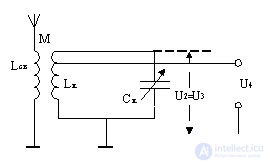Lecture
1924 Amstrong
A superregenerator is obtained if some auxiliary voltage is introduced into the grid circuit of the regenerator lamp or into the base circuit of the transistor  . This voltage would periodically shift the working point of the lamp or transistor from the high-slope region, in which the condition of self-excitation was fulfilled and, therefore, the collation of *** occurred, to the region with small steepness, where the self-excitation condition did not occur and the cola *** decay niy
. This voltage would periodically shift the working point of the lamp or transistor from the high-slope region, in which the condition of self-excitation was fulfilled and, therefore, the collation of *** occurred, to the region with small steepness, where the self-excitation condition did not occur and the cola *** decay niy

Figure 2.4.
With the appropriate selection of the mode, the superregenerative cascade can produce a very large gain (of the order of 1,000,000 or more), and the sensitivity of the receiver in this case is limited only by the level of interference and, first of all, the magnitude of the internal noise of the receiver.
The main disadvantages of the superregenerator are:
- the possibility of obtaining a large gain only at a sufficiently high carrier signal frequency 
(the carrier frequency must exceed the highest modulation frequency by hundreds or thousands of times);
- large non-linear signal distortion;
- relatively wide bandwidth;
- lack of stability regime;
- the difficulty of selecting the optimal mode for a fairly wide range of signal frequencies (i.e.
when the receiver is tuned from the reception of one station to the reception of another station).
Comments
To leave a comment
Devices for the reception and processing of radio signals, Transmission, reception and processing of signals
Terms: Devices for the reception and processing of radio signals, Transmission, reception and processing of signals